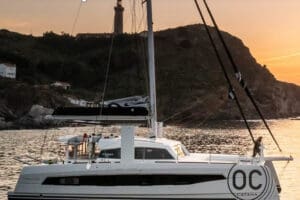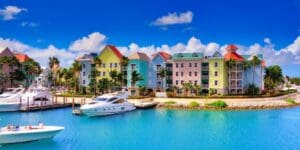We Investigate The CONTROVERSIAL Bali Design Concepts
We bought a new Bali 5.4 Catamaran and will take possession in October 2019! Exciting news, right? Some people are a little perplexed, especially since everybody knows that we love our current catamaran, a Lagoon 450S. It is, in our opinion one of the best sailing catamarans in this size range for live aboard. So, why change?
When we first looked at buying a new catamaran three years ago to place in a Yacht Business Program, we had three competitors in our size and price range; the Lagoon 450S, FP Helia 44 and Bali 4.5. Each had good and not so great qualities but we ultimately settled on the Lagoon 450S. It ticked a lot of the boxes for us at the time and for three years we lived and worked aboard Zuri, sailed 6000 NM, visited exotic locations like Cuba, raced in several regattas, and hosted two catamaran rendezvous events in the Bahamas from her. We had a great time and loved traveling while working on Zuri.
BUT! The Bali catamaran range was of great interest to us right from its inception in 2014. It represents innovation and new concepts in sailing catamarans that is very intriguing, and we followed their progress closely over the years. In September 2018 we visited the Cannes boat show in France where the new Bali 5.4 was launched. We were very impressed and after carefully inspecting the boat for quality and features for the Catamaran Guru website video, we knew that
this boat will be very popular. With the Catana performance pedigree as its foundation, this boat was a game changer for the industry in terms of innovation, use of space, livability and quality.
With no intention of buying a new catamaran, we congratulated the Catana / Bali team on this magnificent vessel and we told them that if we ever wanted to change catamarans, the Bali 5.4 would be our top pick. We went on to create our video and voted the Bali 5.4 our top pick of new designs for 2018. That proved to be a good prediction on our side because it was subsequently also voted Multihulls Magazine’s “Multihull of the Year 2019” by its readership! We were so excited for them and little did we know then, that a mere five months later we would sign a contract for hull #20 of the Bali 5.4 range.
The video at left features details of the Bali highlighted by Boris Compagnon, Sales Director of Bali. Also, see a detailed video of the Bali 5.4 features.
Bali 5.4 Layout Perfect for Our Crewed Charter Business
We operate our boat as a Crewed Charter Business and more accommodation and bigger living space seemed like a great way for us to do our onboard seminars in comfort. This Bali 5.4 has 4 master cabins, crew cabin, custom utility room, huge salon and forward terrace / cockpit and a flybridge big enough to accommodate 10+ people. We needed this crew cabin to be comfortable with a separate shower and toilet for an internship we are about to implement for young people wanting to pursue a sailing career. All in all, the Bali 5.4 is a perfect fit for doing fast ocean passages, traveling in comfort and working onboard with plenty of space for everyone.
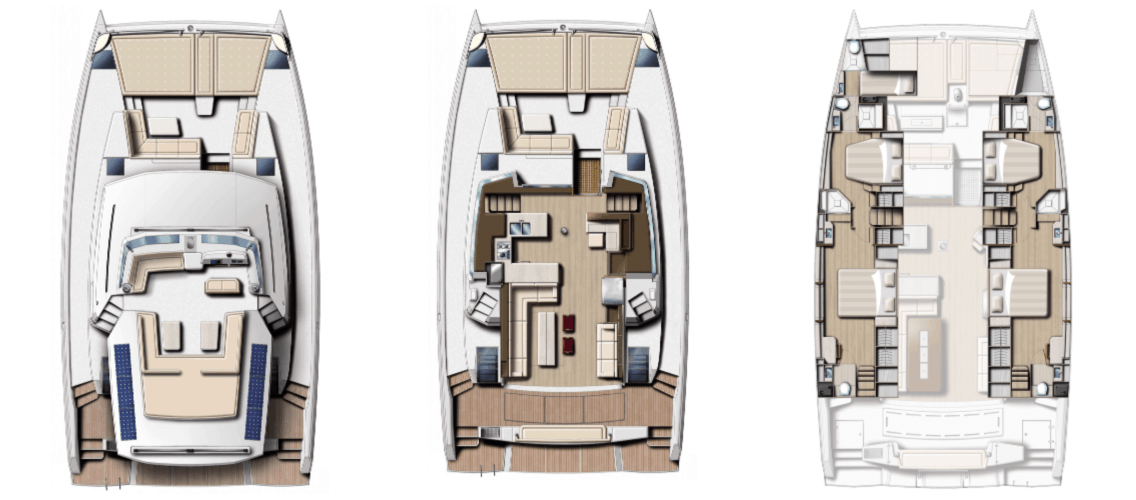
Bali 5.4 Catamaran Features: True Bluewater Cruising Catamaran
When the first Bali catamaran was launched in 2014, it created a stir in the industry. Catana Group owner, Olivier Poncin and designer Xavier Fay, turned conventional thinking about catamarans on its head. They redesigned the entire modern catamaran by implementing innovative design ideas and unconventional and highly controversial concepts. Bali has total market acceptance today. They have now built 300+ catamarans and is the third biggest manufacturer in the world after Lagoon and Fountaine Pajot.
Our 3 Stages of Bali 5.4 Research
Bali gave us unrestricted access to research every aspect of the Bali catamaran range. We visited the factory, interviewed the designer and naval architect, and sailed the boat ourselves. We went through the boat carefully before we made the decision to purchase. After all, this is a substantial “upgrade” for us both in terms of size and price and we run a very diverse sailing business aboard so there were a lot of needs to be met. We wanted to validate the design and construction of the Bali 5.4 are sound.
We are eager and available to talk with anyone interested in Bali catamarans at upcoming boat shows or in our Hollywood, FL, (Fort Lauderdale) marina office. We will also host meetups during our Atlantic crossing in the Bali 5.4 from Europe to Miami and during the ARC Rally. See the schedule of events at the end of this article.
Because our research was detailed, there is a lot to share. So, we will discuss the Bali 5.4 research process and results in three parts, each in separate posts with videos.
- Part One: The Fundamentals
- Part Two: Specifications & Layout
- Part Three: Performance & Sailing
In this post, we discuss part one.
Part One: Bali 5.4 Fundamentals 
- Catana Pedigree
- Bridgedeck Clearance
- Structural Integrity & Construction
- Bulkheads
- Solid Foredeck
- Scupper Draining System
- Rudder Position
- Open Space Design
- Tilting Door
- Interior & Equipment
Picture by Namaste, a luxury crewed charter catamaran in Croatia>>
1. CATANA PERFORMANCE PEDIGREE
The Catana performance catamarans’ DNA is evident throughout this Bali range. Typical features such as the high freeboard, underwater performance hull, lightweight construction, and high-tech building materials demonstrate the Catana pedigree. However, there is a distinct difference in the Bali cruising catamaran range. Poncin specified to designer, Xavier Fay, that since the Bali catamaran range is designed to be a cruising catamaran. This meant adding more living space and enough load carrying capacity without compromising the yacht’s performance.
Unlike monohull boat designs that carry weight without much loss of performance, an overloaded catamaran rapidly loses performance and, eventually, safety. In order to counter this, multihull manufacturers like Bali are continually looking for ways to reduce construction weight to increase potential payload capacity while retaining optimal performance.
Typically, catamarans don’t carry weight well. So once loaded up with all the cruising gear, they underperform significantly. So, Mr. Fay specified that the Bali 5.4 catamaran design had to carry the weight that a cruising cat would usually carry in extra equipment and supplies typically needed for extended cruising. Creature comforts such as generators, washing machine, icemaker, provisioning supplies, and such as well as long-range capacity fresh water and fuel tanks were added. This particular Bali 5.4 has a huge 315-gallon fuel tank and a 315-gallon water tank. A tall order, but Xavier Fay successfully designed an underwater performance hull while utilizing the entire platform with enough buoyancy to carry the weight of equipment and supplies for extended cruising.
The boat has a good power-to-weight ratio, a well-designed hull shape, and robust center of gravity which ensures superior performance. Typically, cruising catamarans have a beam-to-length ratio of about 50% of length overall which is evident on this design. The Bali 5.4 hull has the characteristics of a performance hull underwater, much like a Catana. Above the waterline, it transitions to a chine (see picture below) with wider hull sections which gives it instant buoyancy when the hull submerges while sailing. This wider section above the waterline also enables additional interior volume without compromising the underwater shape. Read our article Cruising Catamaran Performance Debate.
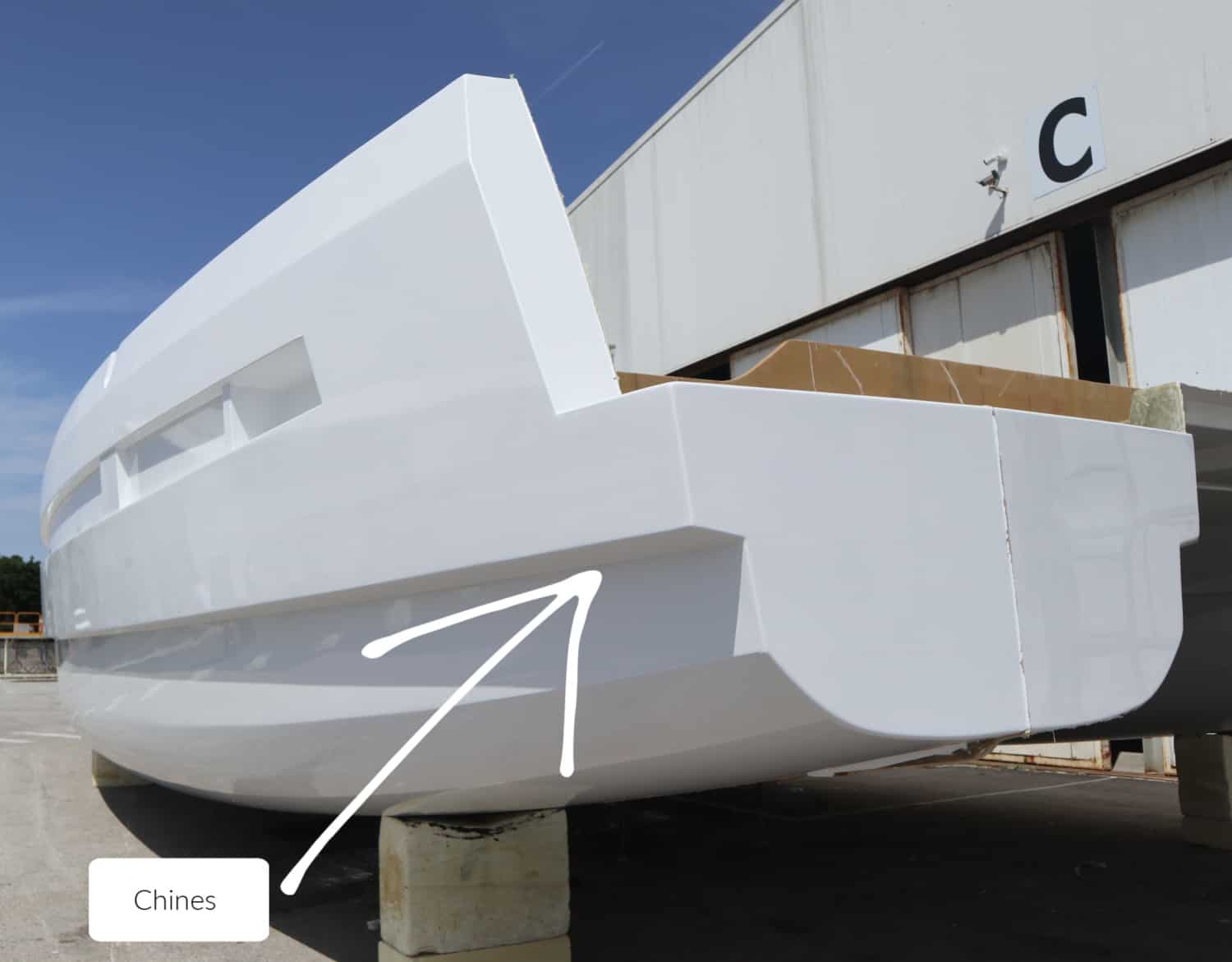
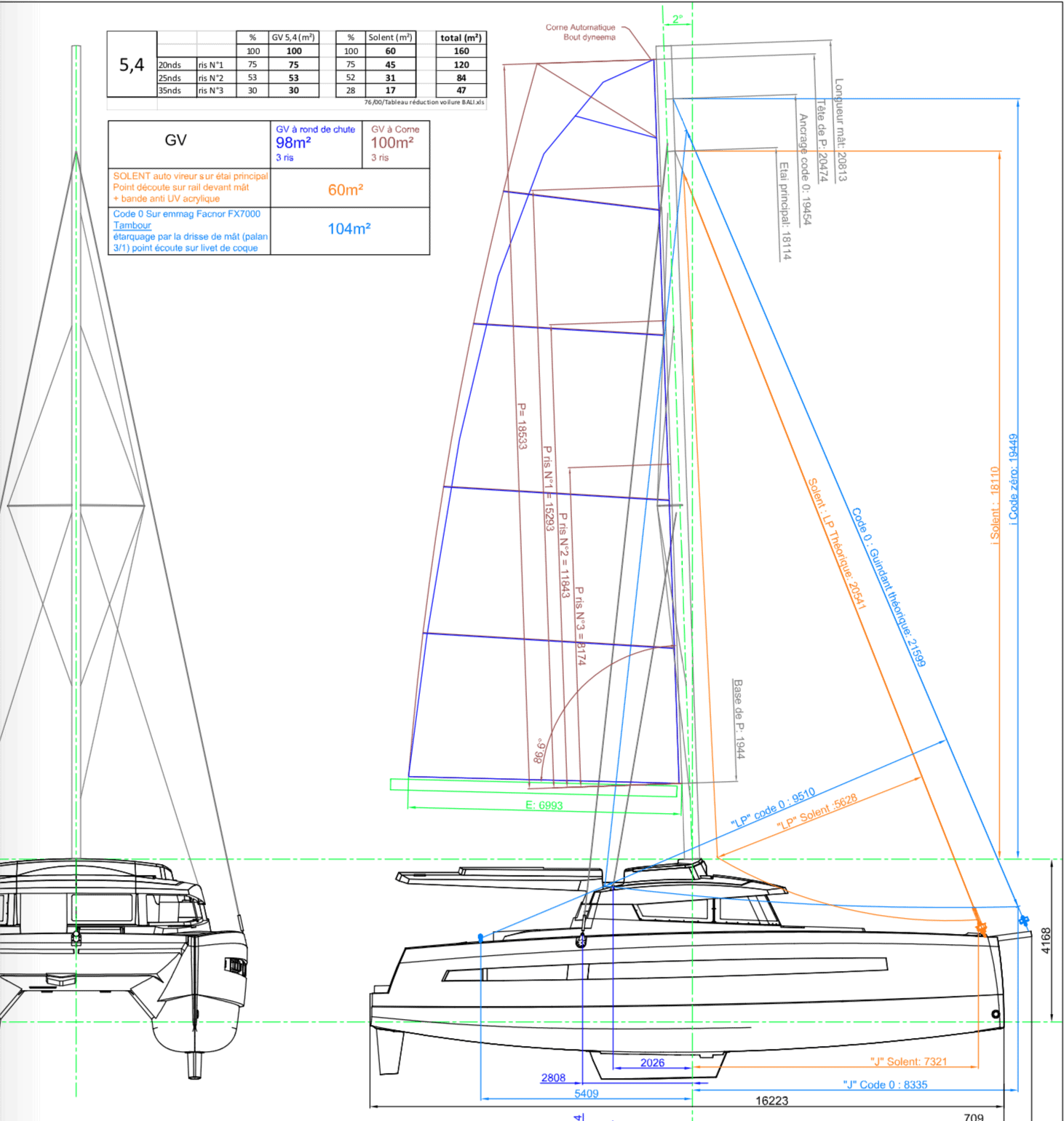
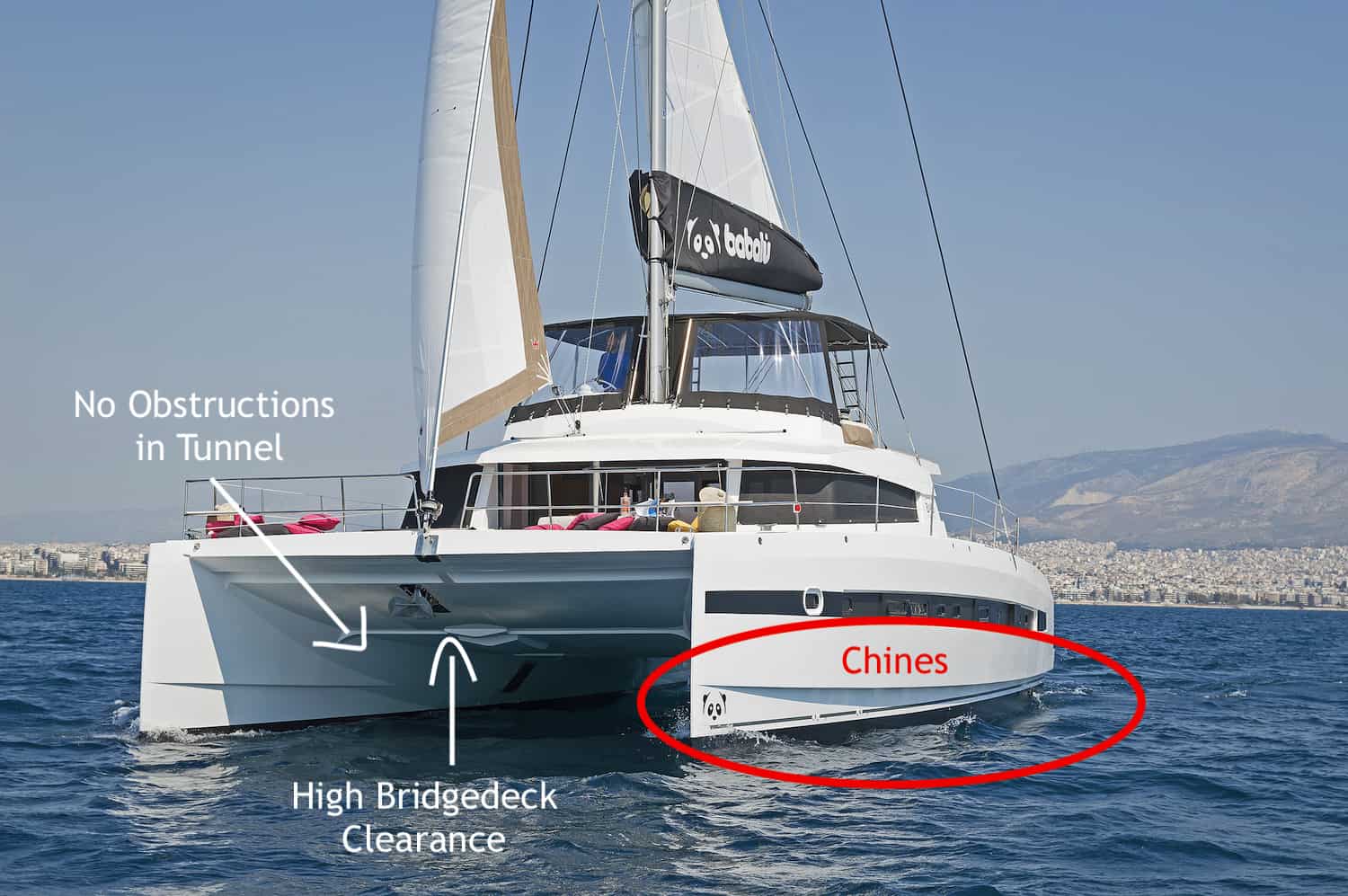
2. BALI 5.4 BRIDGEDECK CLEARANCE
Bridgedeck clearance is important for a catamaran’s seaworthiness and crew comfort. Ocean waves need room to pass between the hulls of a cat. Additionally, it needs space between the hulls for the bow waves that each hull creates separately as these V-shaped waves from the bows meet under the bridgedeck and increasing the wave height and the clearance needed.
Slamming occurs with inadequate bridgedeck clearance which significantly impacts speed and performance. Read our article on bridgedeck clearance on catamarans to see a video explanation of the importance of bridgedeck clearance.
The Bali catamaran has very high bridgedeck clearance and has no intrusions or obstructions inside the tunnel which allows the smooth transition of water between the hulls for minimal noise or slamming. This again is part of the Catana DNA. As a good rule of thumb, 5 to 6% of the overall length is considered to be a good proportion and this design excels in this department.
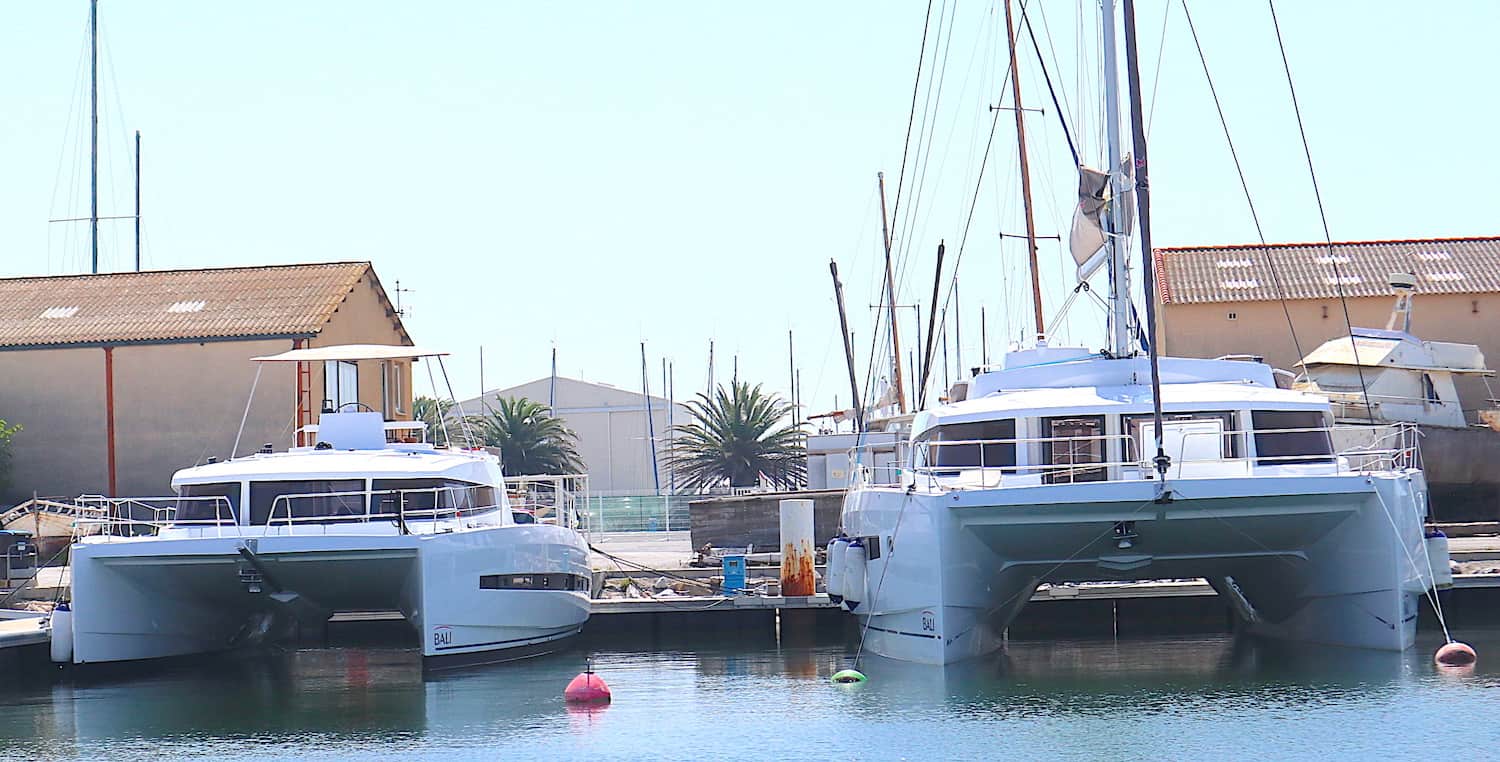
3. BALI CATAMARAN STRUCTURAL INTEGRITY & CONSTRUCTION
Consider that the catamaran’s hulls are actually two boats joined together by a bridgedeck. These “boats” are constantly fighting each other and trying to go in their own direction. The boat structure must be strong enough to counter this and, at the same time, deal with the downforce of the mast in the center of the bridgedeck. The catamaran performs an amazing feat contending with all the opposing forces inherent in the multihull design. For that reason, it is critical to ensure the design and manufacturer are reputable with a track record to demonstrate structural integrity.
The Bali catamaran is full-composite construction with Divinicell closed-cell foam core and is vacuum-infused. This saves significantly on weight. Bali separates itself from other cruising catamarans by using the more expensive Divinicell closed cell foam for the core in the hull versus balsa wood core. This method of construction and the use of these lightweight, but strong, materials produce a very light, rugged, and rigid vessel and minimize flexing for good performance characteristics.
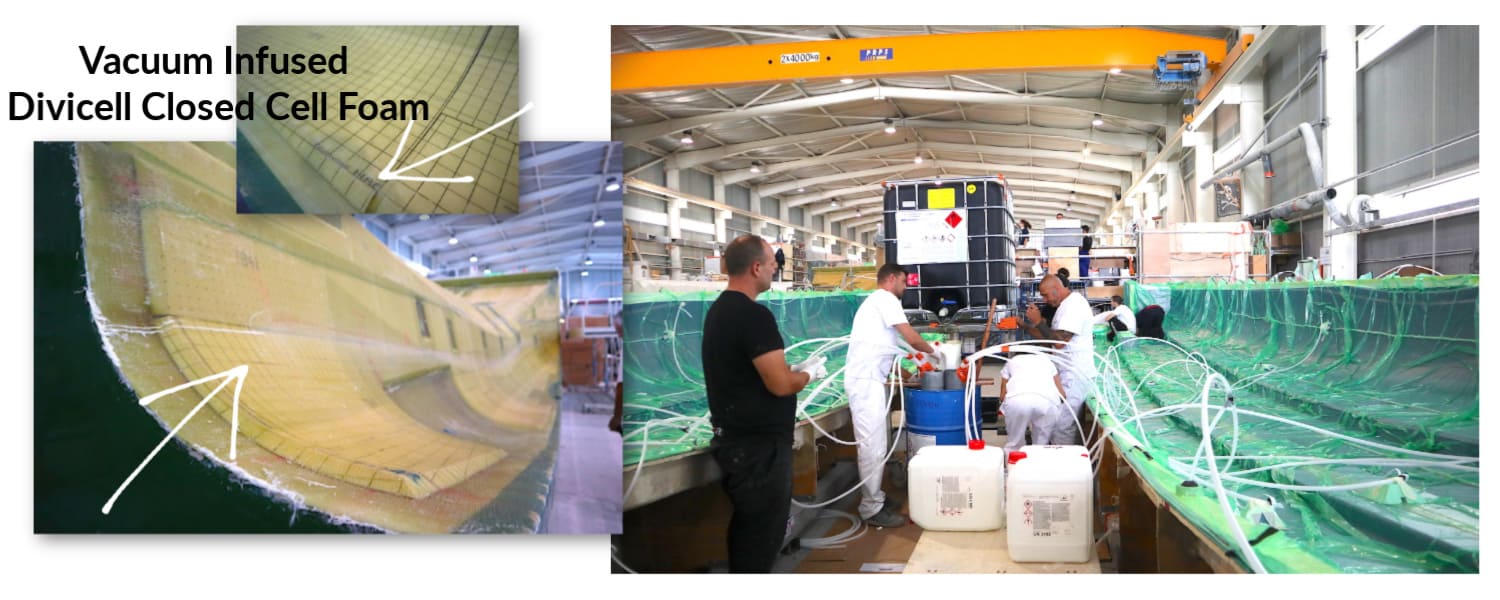
4. BULKHEADS
The Bali has substantial bulkheads throughout for structural strength. All the bulkheads are tabbed and laminated onto the hull and deck which ensures a very rigid construction, much like an aircraft wing. The structure is built on a matrix of box sections in the bridgedeck which enables an open-plan layout with no intrusive bulkheads in living spaces. This construction method provides maximum strength and rigidity, eliminates creaking, and minimizes flexing.


The side of the hull has a recessed section running most of the length of the hull (see the pictures below) which gives longitudinal rigidity for added strength. The port-lights are installed in this recessed area, allowing them to remain open when it is raining, which is a nice feature for cruisers.
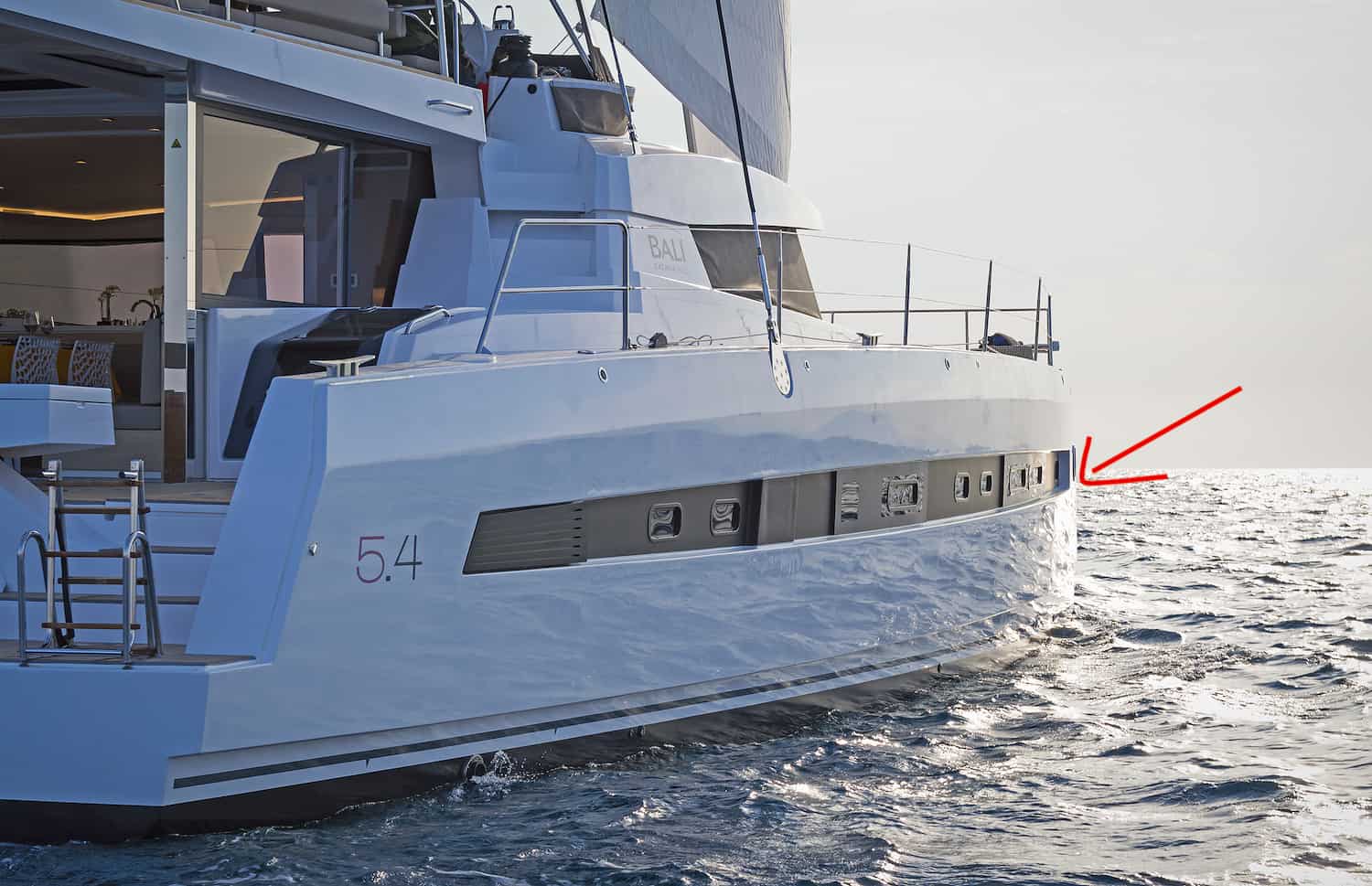
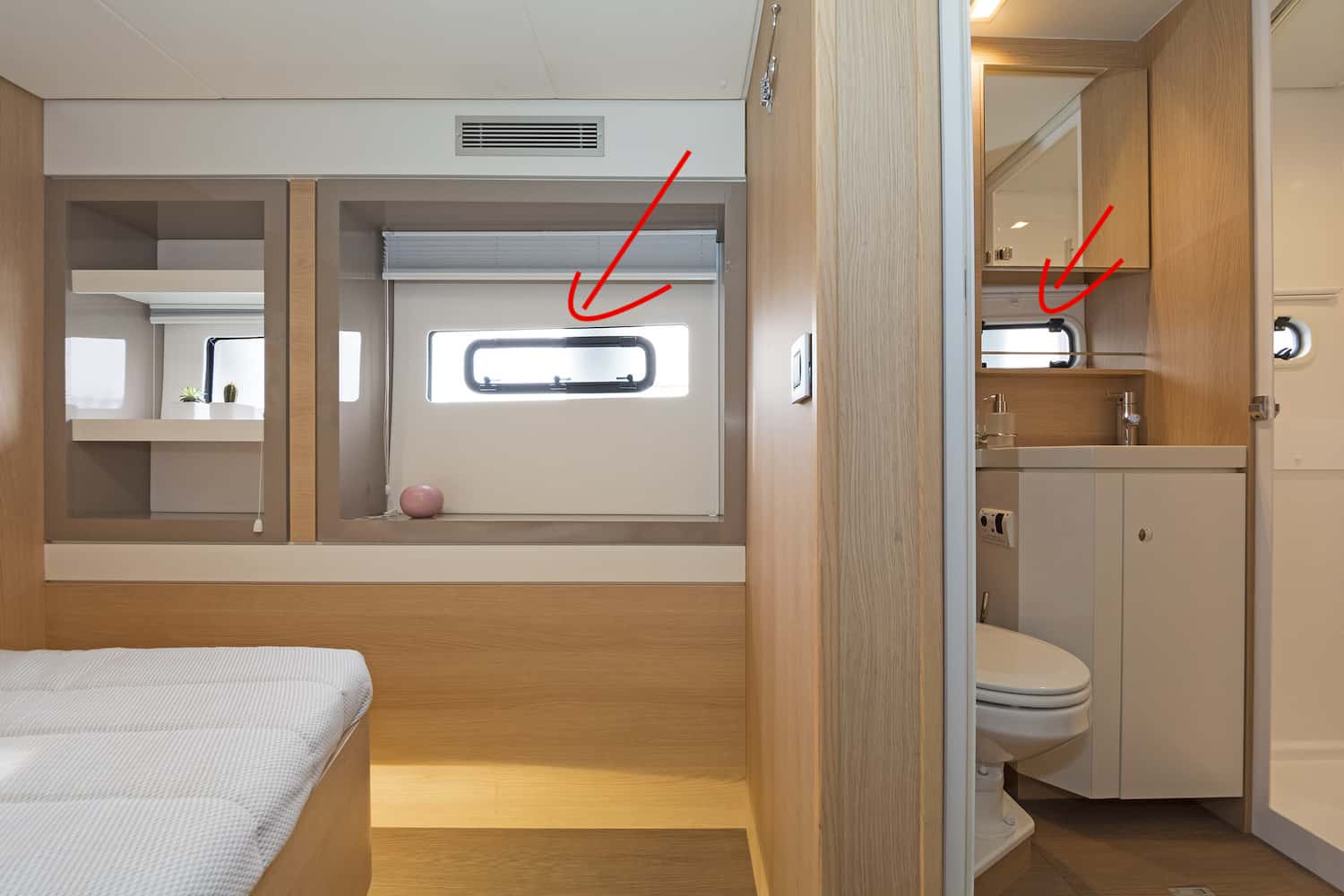
5. SOLID FOREDECK
Probably the most controversial feature of the Bali design is the solid foredeck and with good reason. This has never been done before and has never been tested, or has it?
Some of the oldest production catamarans were built by the Prout family, since the 1950’s in England. They have built around 500 catamarans and one of their more popular models was the Snowgoose 37, built mainly in the 1980s. Prout is no longer around, but the Snowgoose is still a popular cruising boat even today. Looking at the Snowgoose 37, you notice that they are designed with a solid foredeck.
The solid foredeck seems to be the new trend and Bali appears to have won the race to the front with a completely integrated and usable foredeck as a feature. It is not merely another add-on or afterthought, but rather a well-designed integrated feature. The unique box-section construction and lightweight infusion technology enabled Bali to replace the trampoline netting with a solid deck without adding extra weight.
The solid foredeck is attractive for several reasons. It increases the usable living space substantially and is really comfortable and very dry in most conditions compared to the traditional netting. Recent models by many catamaran manufacturers are aiming to reduce the size of their nets while increasing accommodations by moving the deck forward.
Bali’s solid foredeck is the strongest construction for a catamaran design because it is part of the bow structure rather than a flimsy joint between the hulls. This contributes to the rigidness of the boat, making it much stronger than conventional catamarans with two bows joined by a crossbeam and netting. The acute angle of the underbody of the solid deck and the buoyancy of the solid foredeck cause the bows to lift up rather than dive into the waves which improves performance and safety even further. Read more about the Bali catamaran solid foredeck.
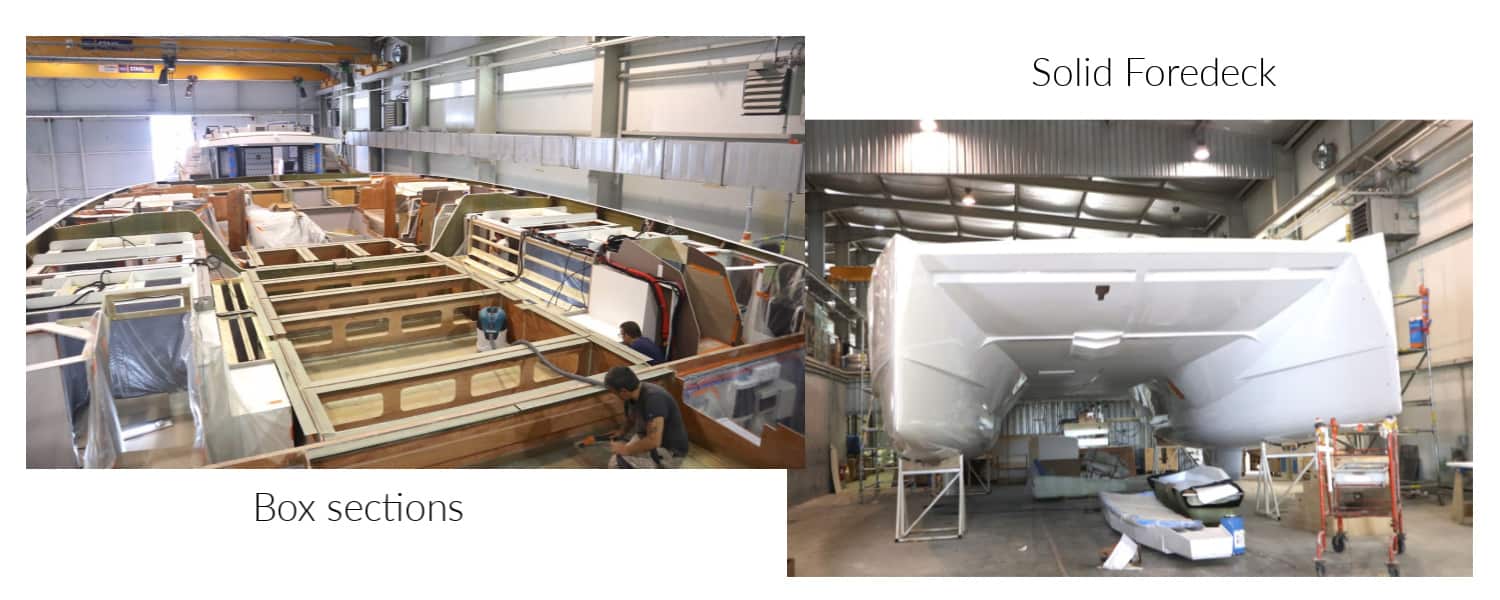
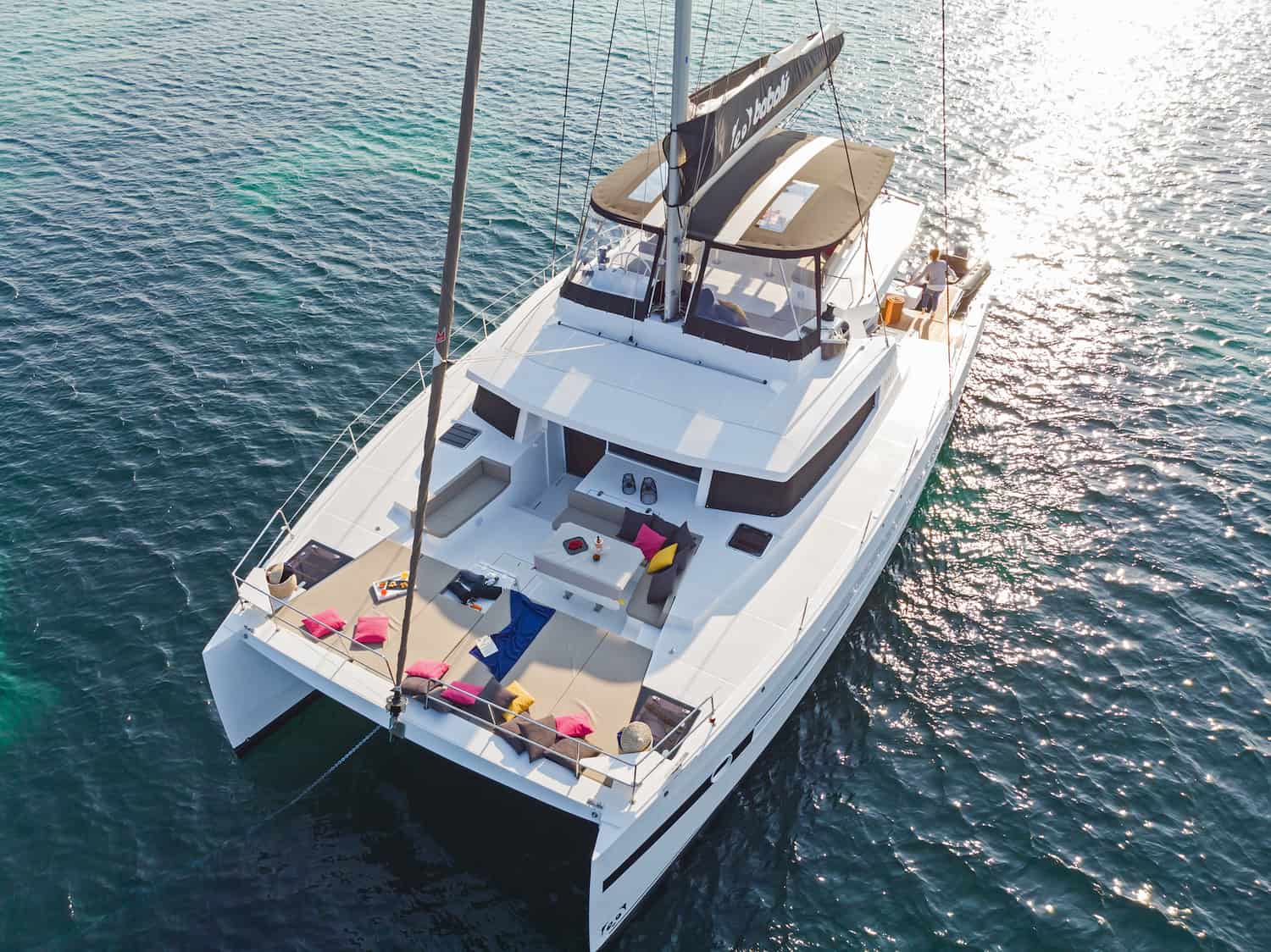
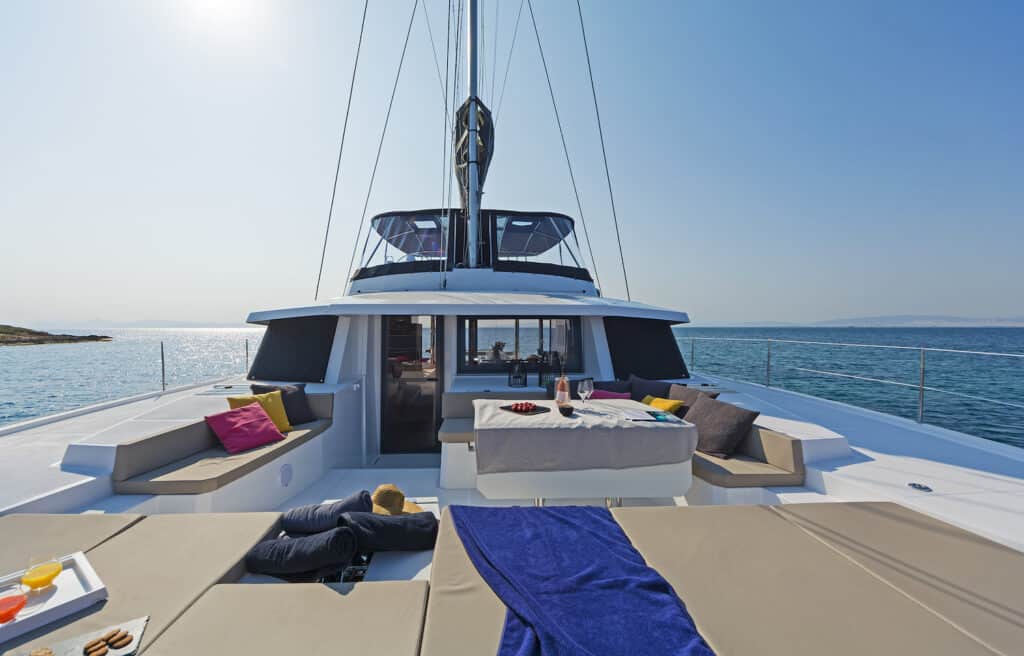
6. DRAINING SCUPPER SYSTEM
The solid foredeck and living area require a very effective scupper system to drain any water that is taken over the bows. The water drains efficiently and quickly through a very unique and clever draining system. The water drains through a big opening in the well down into the nacelle. It is fitted with three backward facing scuppers, mounted in a step, which is molded into the center nacelle. In the event that the foredeck gets swamped, the water can be purged quickly with no pushback. Designer, Xavier Fay, made sure that the rate of draining the cockpit complies with the building code requirement of 15 seconds and, in fact, improved it to 12 seconds which is 20% better than code requirements.
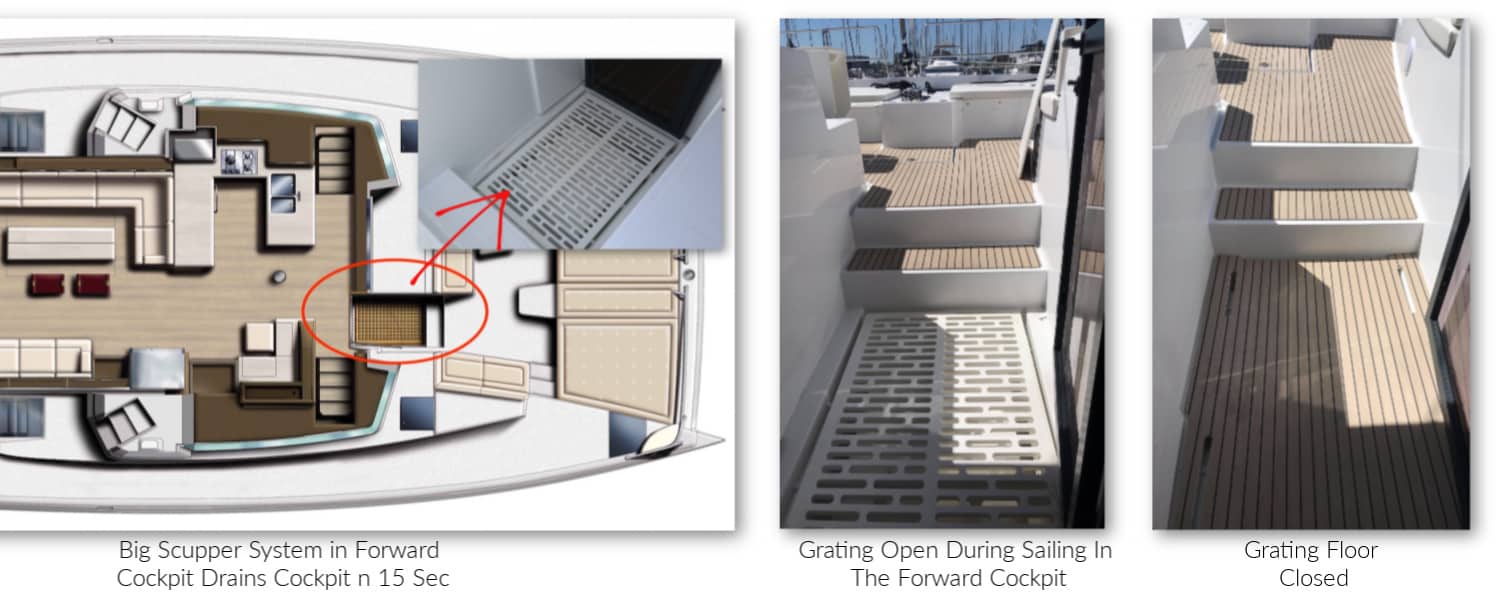
7. RUDDER POSITION
The Bali has the rudder positioned far back and aft of the propeller yielding good tracking ability under sail and maximum response and maneuverability. Having the rudder aft of the propeller enables to use of the propwash to kick the stern in one direction or the other. Most production cats have their propellers aft.
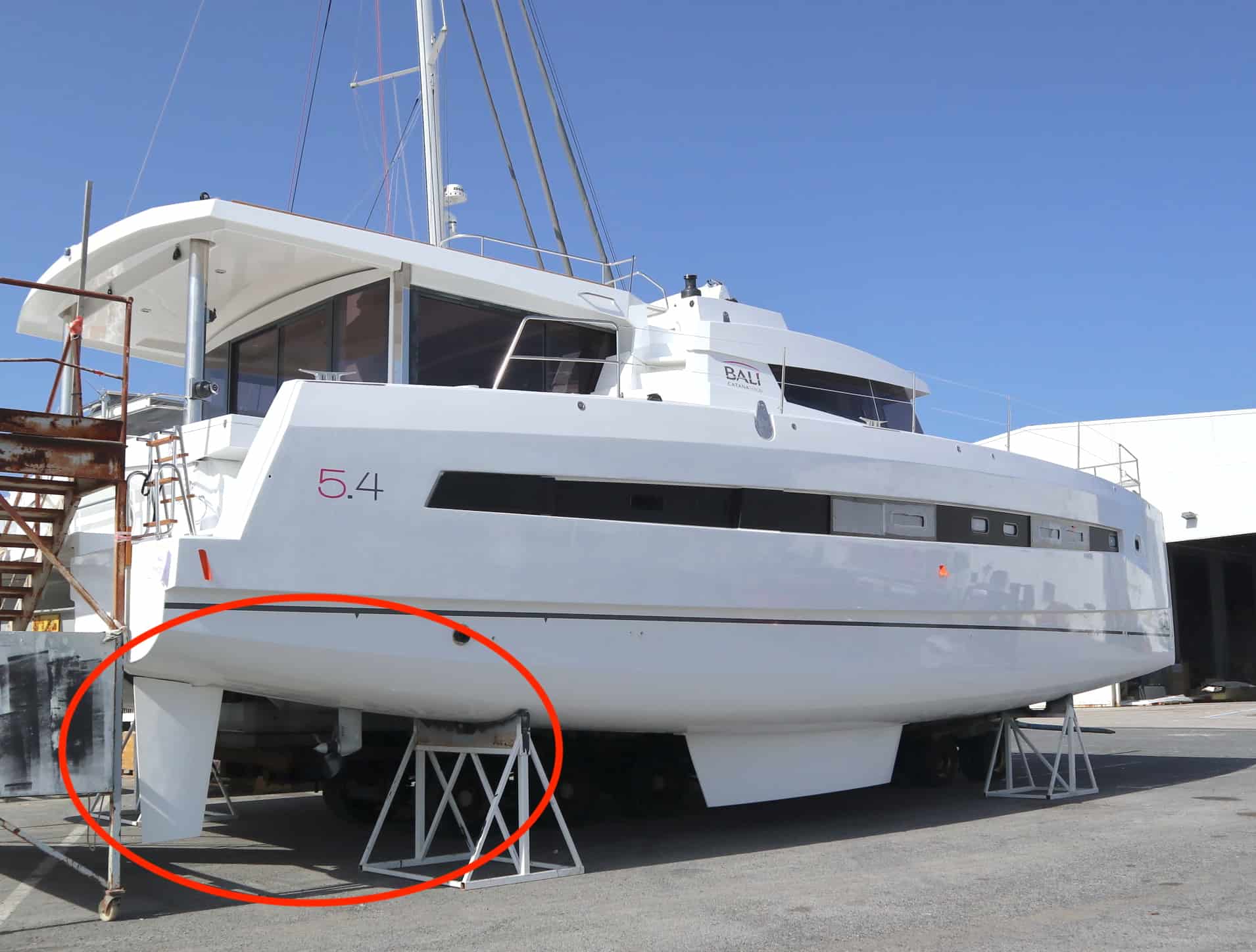

8. OPEN SPACE DESIGN
The living space of a Bali catamaran is much bigger and more effectively used than a traditional catamaran layout. The living space was increased across the entire platform by eliminating separate living spaces and integrating it into one big open space without restrictive bulkheads.
The innovative box section construction made this possible and opened the entire platform from the bows to the stern. The forward-thinking design puts this boat ahead of the curve and sets a new standard in comfort, safety, and performance. As an example, the Bali 5.4 has 1,381 sq ft of usable living space versus a Fountaine Pajot Ipanema 58 at 1,298 sq ft or a Leopard 58 at 1,295 sq ft. That’s more than 80 sq ft more of usable living space…a full 8′ x 10′ room worth!
SIMILAR CATAMARAN COMPARISONS

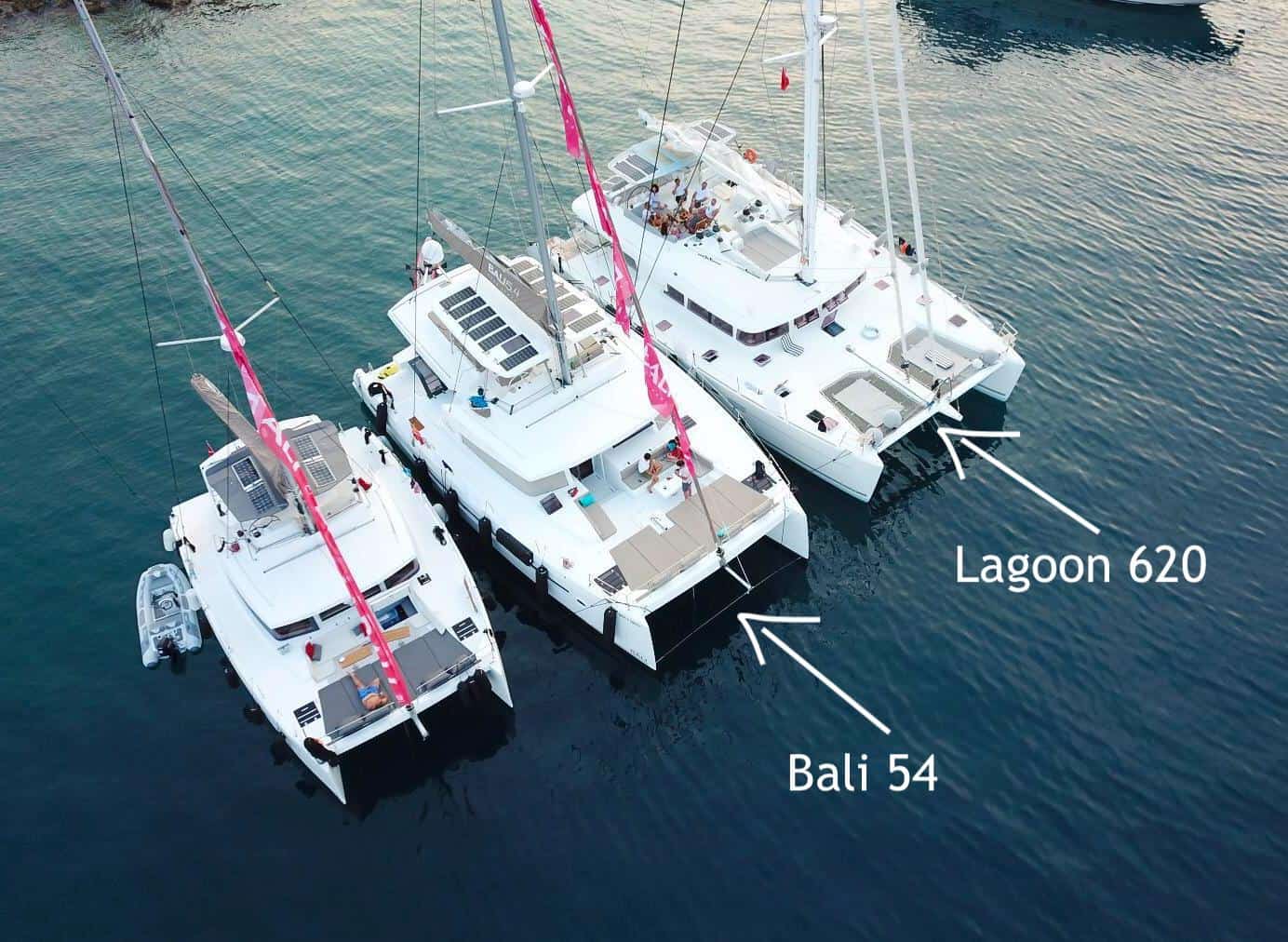
BALI 5.4 CATAMARAN LIVING SPACES: SALON

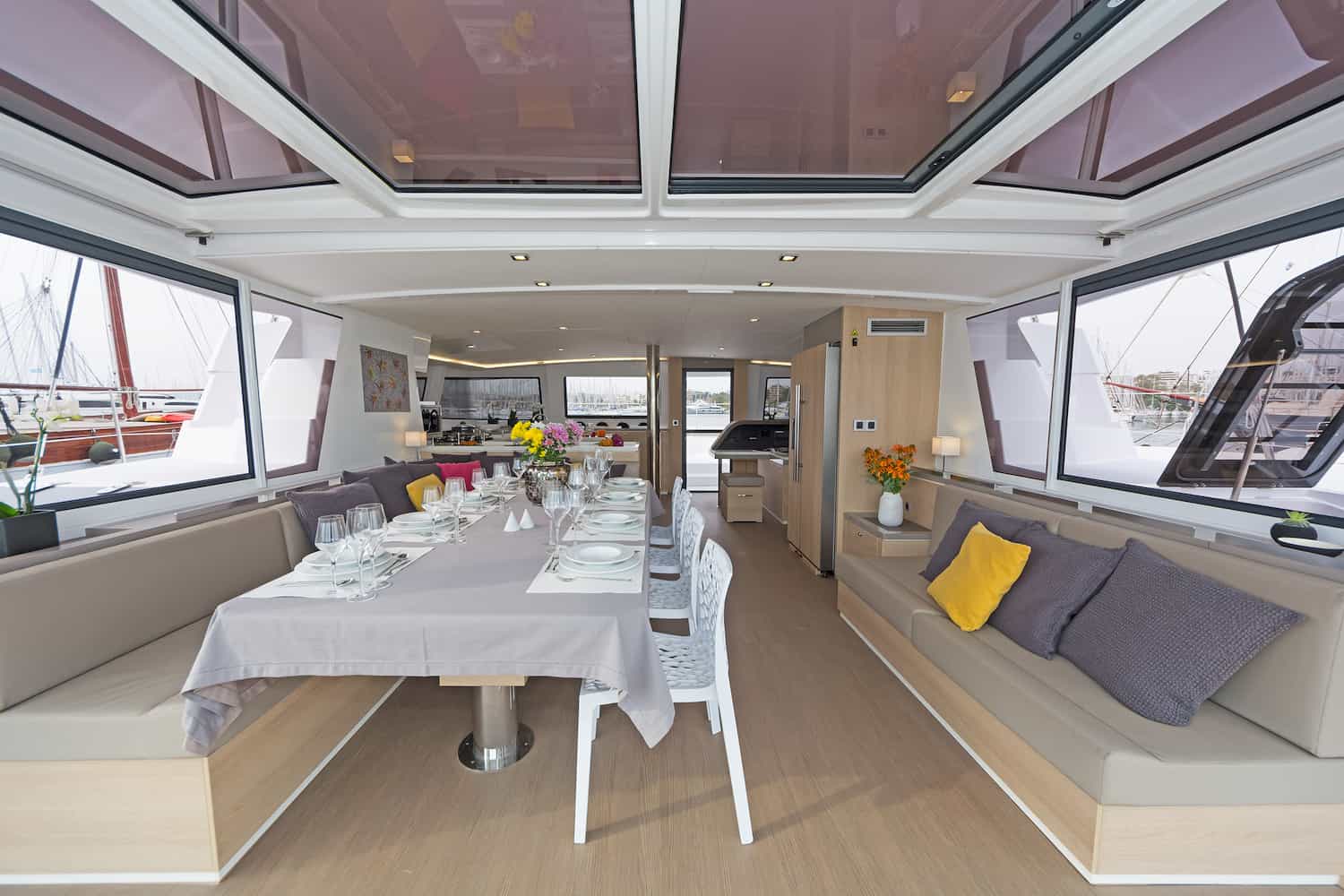
BALI 5.4 CATAMARAN LIVING SPACES: FRONT COCKPIT

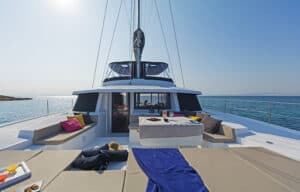
BALI 5.4 CATAMARAN LIVING SPACES: FLYBRIDGE
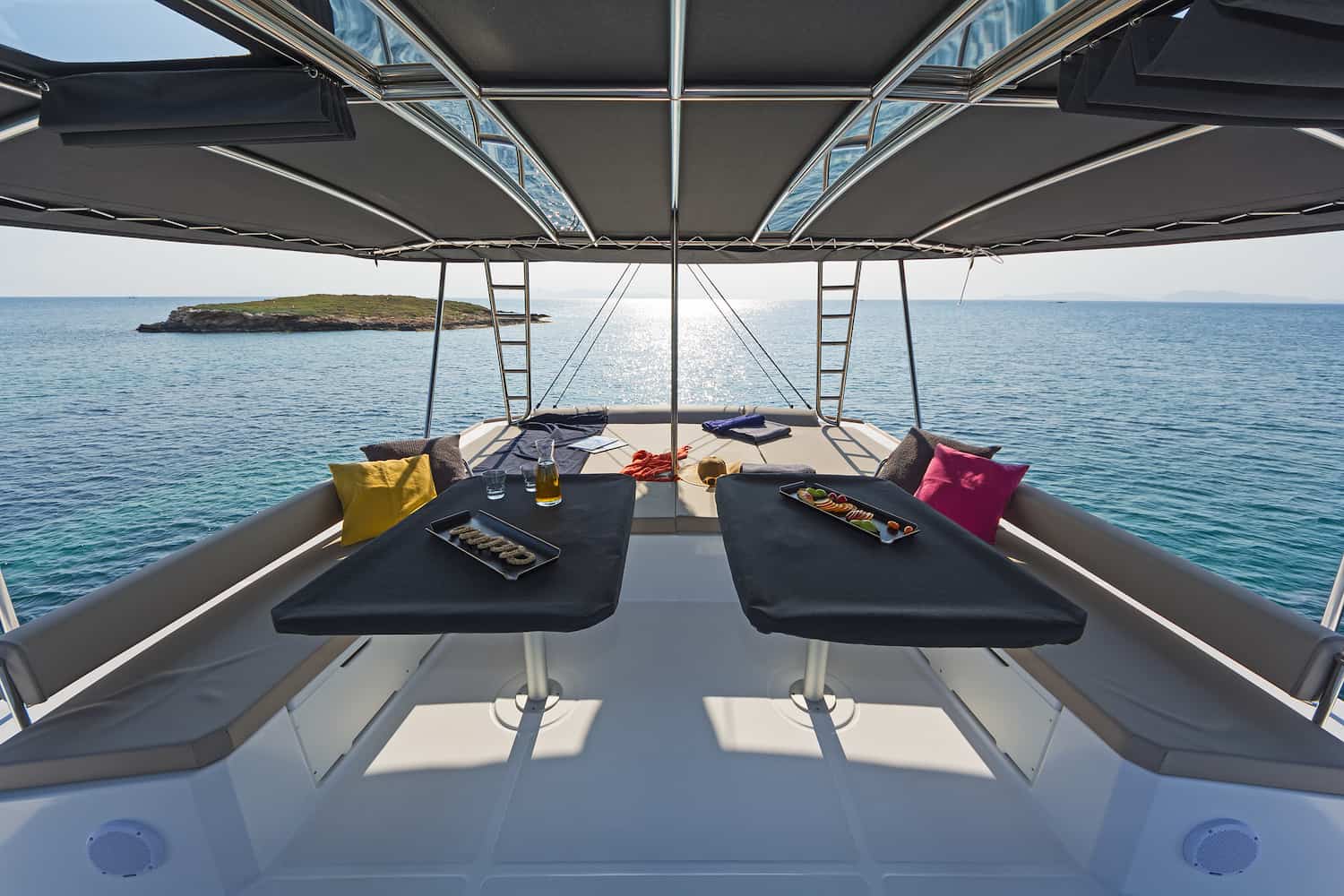

9. BALI 5.4 UNIQUE TILTING DOOR
The tilting door is another of Bali’s controversial features viewed with much skepticism in the industry. Today, it seems to be one of the most popular features. It makes total sense. By eliminating restrictive bulkheads, the interior saloon area can now be integrated with the outside cockpit area and become one big open space by tilting this door up and away into the roof.
When down in locked position, the tilting door protects the crew from the elements. But when tilted up, it completely disappears into the roof to enable an oversized open aft cockpit. The living space created by the open tilting door is impressive and when open along with the front door and side windows open, the ventilation negates the need for air conditioning. When the door is closed it creates a salon and living space unmatched by any boat below 70 foot. It has more living space than any other boat in of its class.
The door is operated with a hydraulic unit, a very powerful and efficient system. In the event of a failure, an emergency valve still allows the door to be lowered on gas-filled struts. It’s important to note that the design of this tilting door has a significant redundancy built in. That guarantees the absolute safety of the user at all times. The rams are doubled-up and equipped with fall-arrest valves. The traction cables are also doubled-up for each of the rams.
A customized sealing system has been developed for each Bali model for the lower part of the doors to create a watertight seal in the saloon. On the peripheral part of the pivoting and tilting door, a brush system creates a windproof barrier. These two systems provide a good seal. This innovation complies with the required building codes and is a feature that works well. With more than 200 boats built with this design, it has been perfected and functions flawlessly.
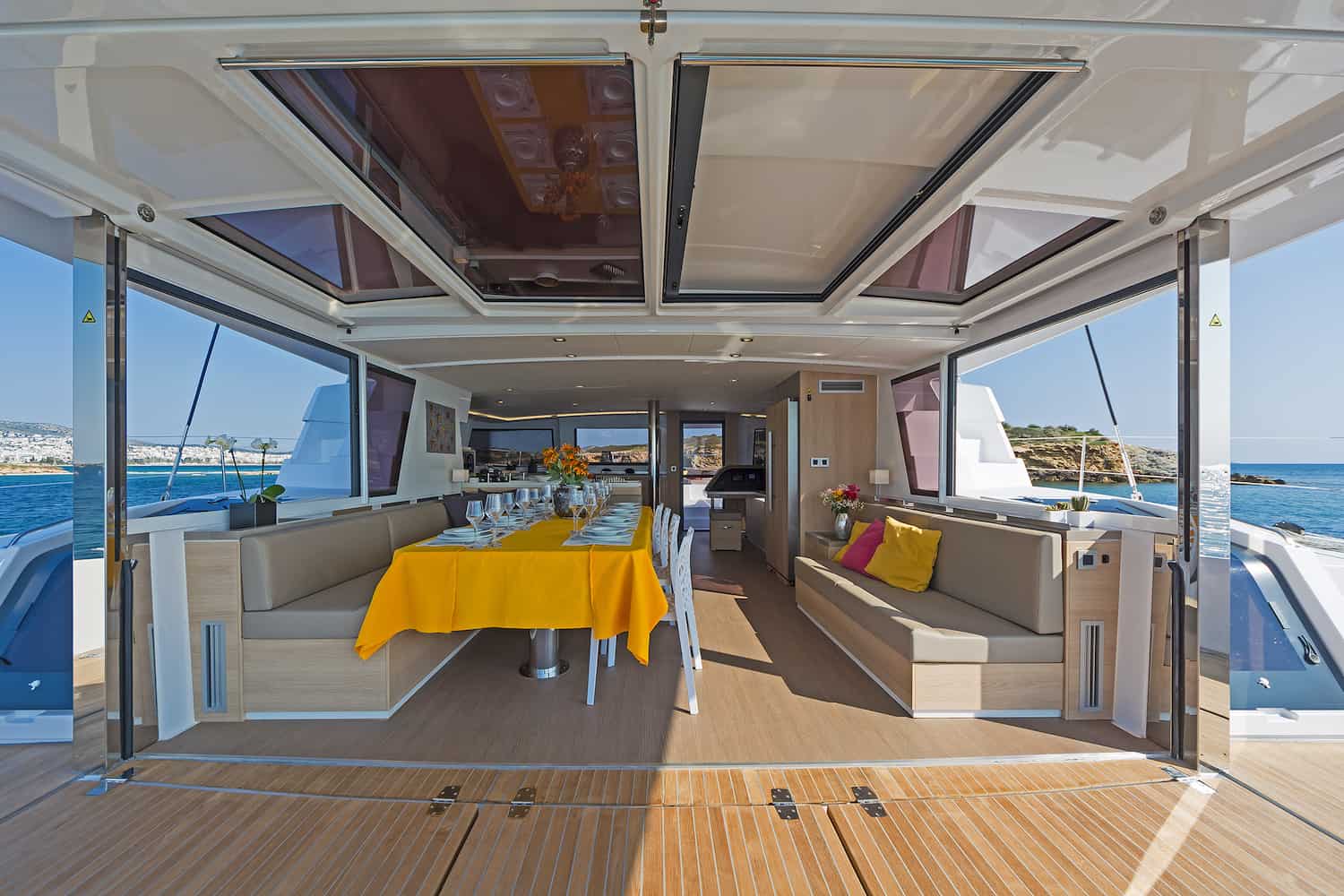
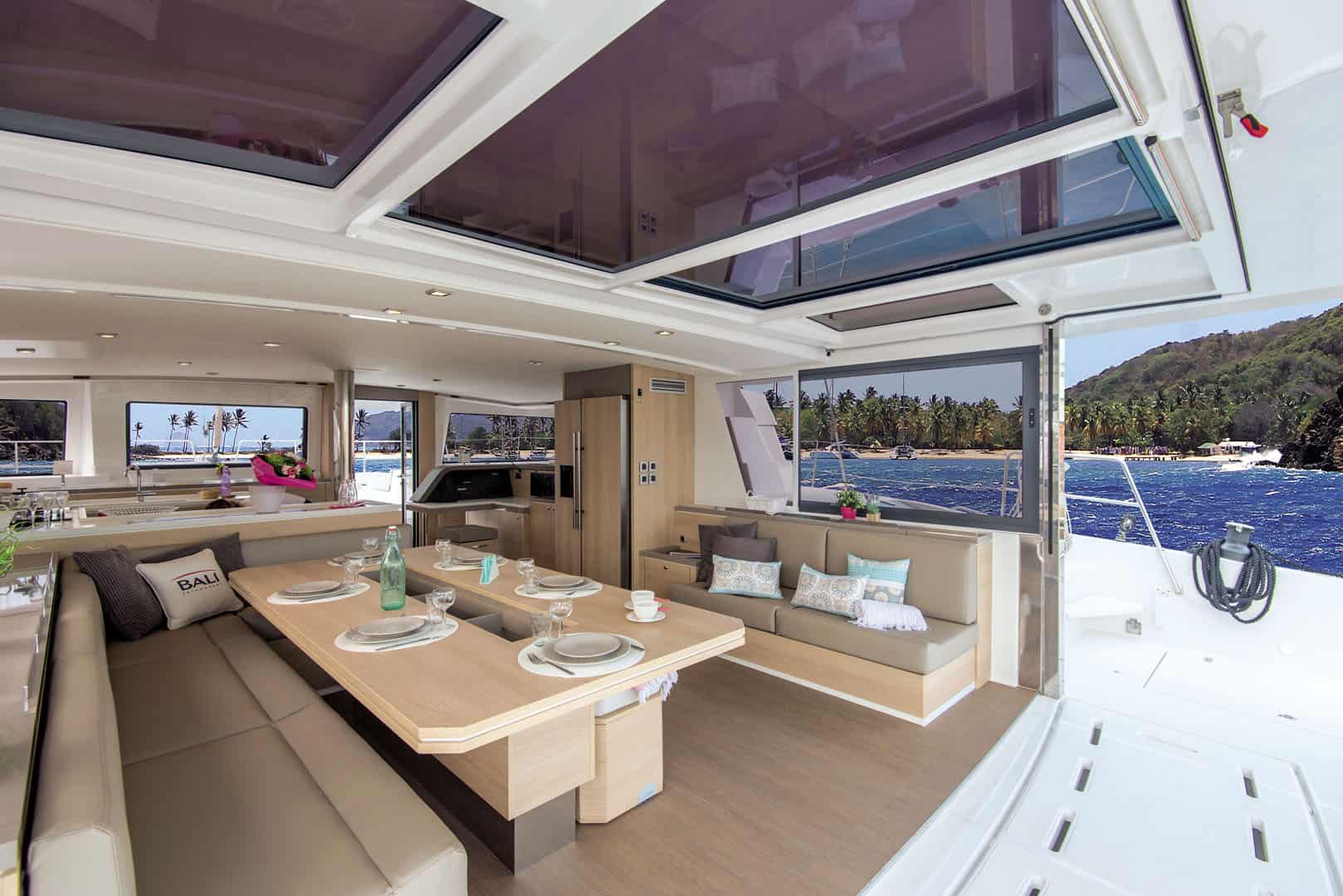
10. QUALITY INTERIOR & EQUIPMENT
The new upgraded wood package and interior, as well as fit and finish, is vastly improved and the interior is very comfortable. The equipment is all high quality from top manufacturers such as Lewmar, Lofrans, Victron, and Yanmar. We will discuss our specifications list, upgrades and customizations in our next video and post.
The full-size “American” refrigerator with built-in ice maker and cold-water dispenser was another controversial feature on the Bali catamaran range. People made fun of this at first, but believe me, it is something you get used to very quickly and not something one would want to be without once you have experienced it. Since it is a feature in mega yachts, Bali decided to do the same in regular catamarans and it is a winner!
Watch this video of the Atlantic crossing of one of the first Bali 4.5’s that came across to the USA. The fridge is feature prominently in the video and demonstrates that it really works perfectly well even in rolling seas despite speculations that it was a bad idea.


EVENTS: MEET US ON OUR BALI 5.4!
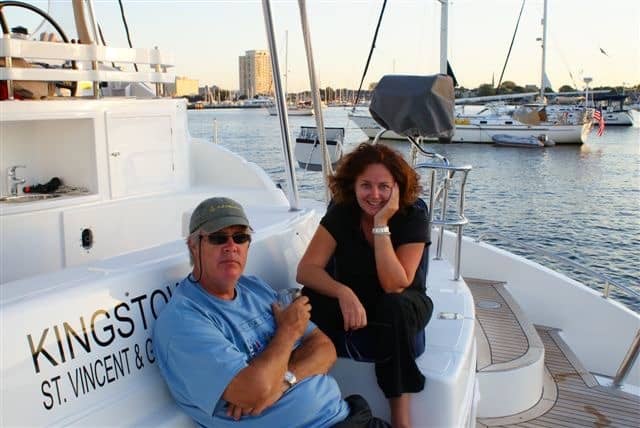 We bought our “favorite” new catamaran and will take delivery in August 2019. While we take delivery in August, our boat will make the rounds at European boat shows before we take possession to traverse the Atlantic as part of the ARC Rally. Meet up with us at one of the events to tour a Bali 5.4! Both Stephen and Estelle will be available at the events.
We bought our “favorite” new catamaran and will take delivery in August 2019. While we take delivery in August, our boat will make the rounds at European boat shows before we take possession to traverse the Atlantic as part of the ARC Rally. Meet up with us at one of the events to tour a Bali 5.4! Both Stephen and Estelle will be available at the events.
Cannes Yachting Festival, September 2019
At Cannes Yachting Festival boat show September 10-15th, 2019, we are offering a chance for anyone interested to join us aboard our Bali 5.4 for a tour or to attend the Bali cocktail party!
Annapolis Boat Show, October 2019
At the Annapolis Boat Show, October 10th -14th, we will gladly walk any interested buyers through our client’s Bali 5.4 which will go into crewed charter.
ARC Rally, November 2019
Aboard our new Bali 5.4, we will participate in the ARC Rally to cross the Atlantic starting on Sunday 24 November with a fleet of about 200 boats sailing 2700 NM across the Atlantic from Gran Canaria to Saint Lucia. We expect to be at sea for about 10-15 days on the classic trade wind route.
Miami Boat Show, February 2020
As we sail up the island chain to the Miami Boat Show, February 13-17, 2020, we will do several meetups, events, boat shows and seminars onboard our Bali 5.4. to meet with interested buyers and other catamaran sailors!
If you are on our Catamaran Guru Insiders’ List or following Catamaran Guru on Facebook or Instagram, you will stay updated on our calendar of events and we will share videos and pictures throughout our journey! Read about our adventure aboard our new Bali 5.4.



